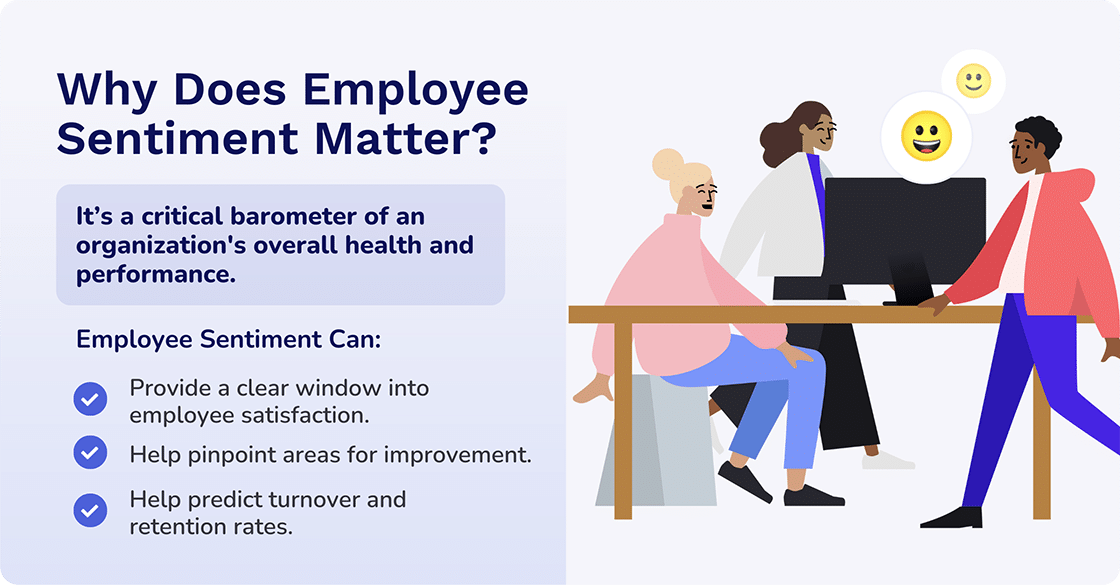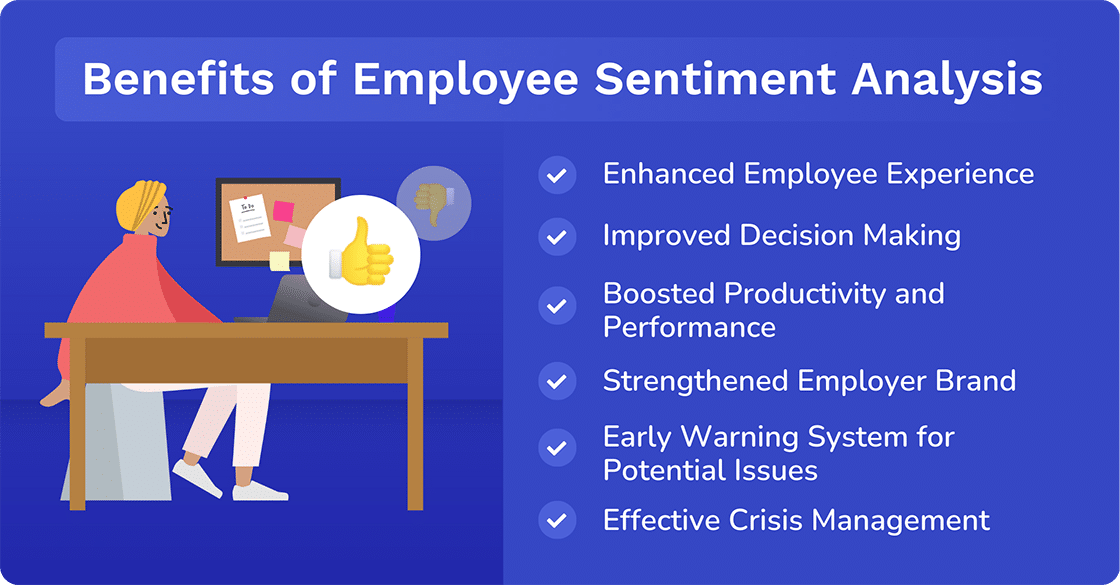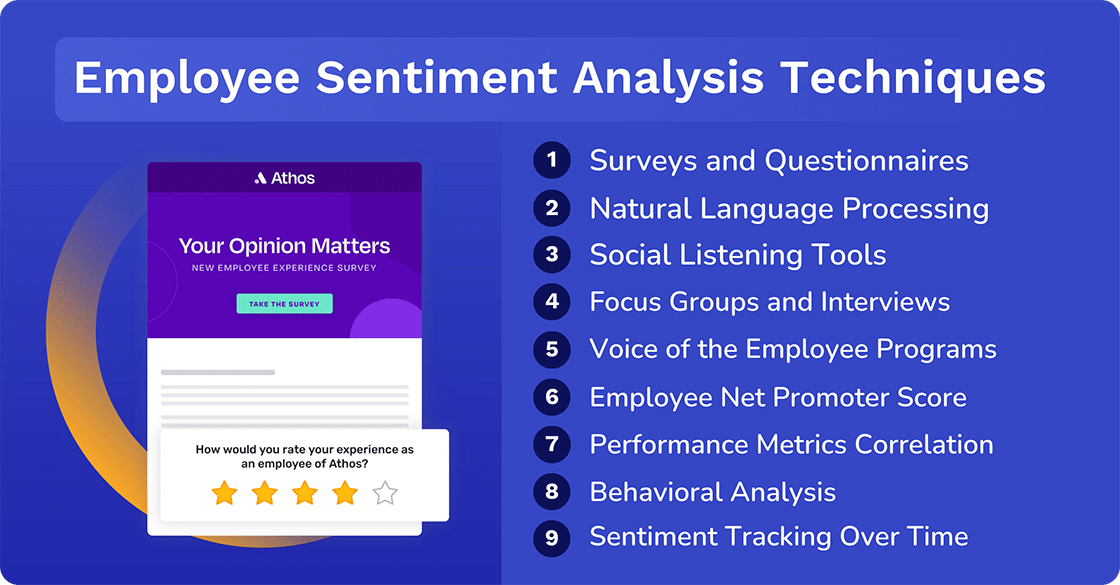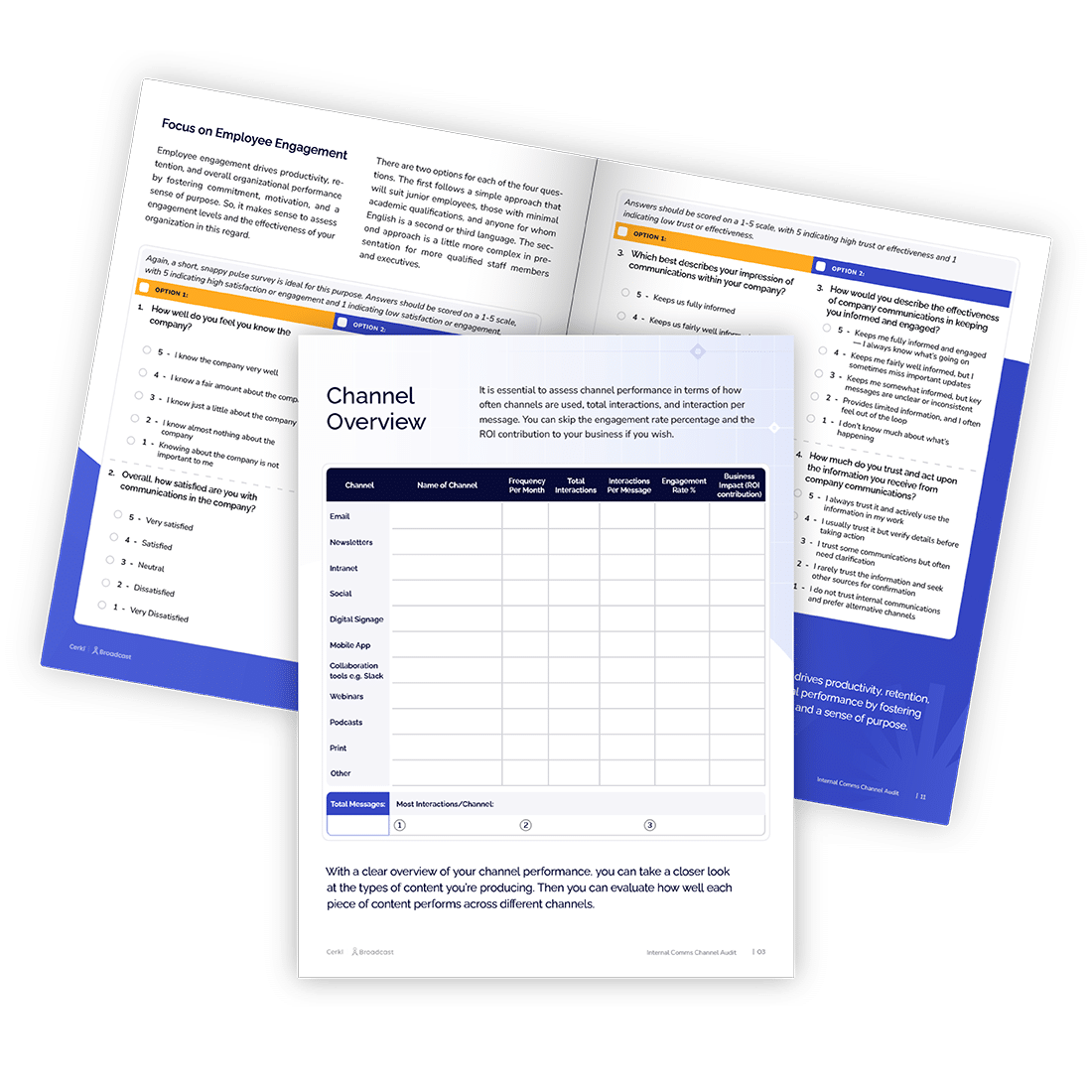 Internal Communications Measurement
Internal Communications Measurement
Want to up your game and improve employee engagement and your bottom line? An employee sentiment analysis can help you do this. We show you why and how.

.png)
Strategy is an important component of internal communications. Ensure you’re communicating through the right channels at the right frequency with our Internal Communications Channel Audit worksheet.
Access NowIn today's dynamic business landscape, effective internal communication is paramount for fostering employee engagement, productivity, and overall organizational success. Yet, gauging the effectiveness of internal communication efforts can be a complex challenge.
You try to guide your leaders to a more positive and effective message, but sometimes they won’t hear you. A few of these unsuccessful interactions can get you a reputation for being negative, or you may give up entirely. Sound familiar? Don’t worry. Artificial intelligence-powered sentiment analysis can remove you from the role of naysaying “bad guy” and instead frame you as the wise strategist you were born to be.
If you don’t know much about sentiment analysis, this post will show you what a powerful tool it can be. Artificial intelligence (AI) has become the backbone of modern employee sentiment analysis. It is revolutionizing the way organizations measure and improve their internal communications. By meticulously analyzing employee feedback and employee sentiment expressed across various channels, organizations can gain invaluable insights into the effectiveness of their messaging. It can help identify areas for improvement and ultimately create a more engaged and informed workforce.
Sentiment analysis goes beyond traditional survey methods by providing real-time insights into employee perceptions and reactions. By harnessing the power of data, organizations can uncover hidden trends, identify emerging issues, and measure the impact of communication initiatives. This data-driven approach empowers leaders to make informed decisions, tailor messaging to specific audiences, and build a culture of open and honest communication.
The potential benefits of leveraging employee sentiment analysis for internal communications are vast. By understanding employee sentiment, organizations can enhance employee experience, boost morale, and improve overall business performance.
This post will delve into the intricacies of sentiment analysis, explore its applications in internal communications, and discuss best practices for implementation.
Employee sentiment analysis involves evaluating the words and phrases used in communication to determine the underlying emotions. It assesses whether the tone is positive, negative, or neutral, providing valuable insights that help organizations tailor their messages for maximum impact. This ensures employees feel understood, valued, and motivated, fostering a positive work environment.
In an article published in The Washington Post in March 2024, Bob Helbig, the media partnerships director at employee survey firm Energage, refers to employee sentiment analysis as “the collective state of mind in the workplace.” It can be captured using surveys or interviews or by using sentiment analysis software. It’s like taking an X-ray of an organization, he says. His definition of employee sentiment is worth sharing.

“Employee sentiment is a vital aspect of understanding how workers feel about their workplace. It goes beyond the concept of employee engagement. Employee sentiment is about identifying the authentic emotions and perceptions driving employee experiences.“ Bob Helbig
His article, Measuring Employee Sentiment and Why It Matters, highlights how poor employee sentiment analysis can result in decreased productivity, higher turnover rates, and ultimately impact company culture negatively.
By aggregating and analyzing employee feedback, organizations can uncover patterns and trends that illuminate the overall health and well-being of the company. Employee sentiment serves as a barometer for workplace conditions, offering insights into factors impacting productivity, company culture, and employee satisfaction.
Employee sentiment is a critical barometer of an organization's overall health and performance. By understanding how employees feel about their work environment, organizations can gain valuable insights into various aspects of their business.
Firstly, employee sentiment provides a clear window into employee satisfaction and engagement levels. Happy and engaged employees are more likely to be productive, innovative, and loyal to the organization. Secondly, analyzing employee sentiment can pinpoint areas where workplace culture can be improved. By identifying recurring themes in employee feedback, organizations can address issues proactively and foster a more positive work environment. These may vary according to employee roles and positions, so it is worth taking this into account.
Employee sentiment is also a strong predictor of turnover and retention rates. High levels of employee satisfaction and engagement are linked to lower turnover, while negative sentiment can indicate potential departures. Moreover, employee sentiment directly impacts productivity and motivation levels. When employees feel valued and supported, they are more likely to be motivated to excel.
A research paper published in the International Journal of Professional Business Review has some interesting statistics. Workplace Productivity Through Employee Sentiment Analysis Using Machine Learning states that most responses indicated a positive correlation between positive sentiments and high productivity levels. More specifically:
Ultimately, employee sentiment shapes an organization's reputation and employer brand. Positive sentiment translates into a strong employer brand, attracting top talent and building customer trust. By prioritizing employee well-being and fostering a positive workplace culture, organizations can enhance their overall reputation.
Additionally, employee sentiment data is invaluable for informing decision-making processes related to HR policies and practices. By understanding employee needs and preferences, companies can implement initiatives that improve employee experience and drive business success.
Upgrade your company’s internal comms to enhance employee communication

Sentiment analysis isn’t new. However, the field as we know it today emerged with the advent of digital technology and the massive growth of online data. And it has grown exponentially with the application of machine-learning techniques. Early methods focused on rule-based systems, relying on predefined dictionaries of positive and negative words to determine the overall sentiment of a text. These methods were limited in their ability to handle complex language structures and nuances.
Researchers began developing algorithms capable of learning from large datasets of labeled text, enabling more accurate and nuanced sentiment classification. The rise of social media platforms further accelerated the development of sentiment analysis, as it provided an unprecedented amount of data to train and test these algorithms.
Today, employee sentiment analysis is a mature field with a wide range of applications across industries, from marketing and customer service to politics and finance.
With the advent and rapid development of AI, it has become the driving force behind contemporary sentiment analysis. Why, you may ask?
Employee sentiment analysis works to determine the attitude of the person speaking or writing. It helps internal communicators identify how their words make people feel. Analyzers look at the words you are using and assign them a feeling, like anger, fear, joy, sadness, analytical, confident, or tentative. This approach shows that the tone, general character, or fundamental quality of communication is hugely important.
Tone is the unspoken language in communication. It holds immense power in shaping employee perception, employee engagement, and overall organizational culture. It's the emotional undercurrent that accompanies the message, influencing how it's received and interpreted.
In internal communications, tone is crucial for building trust, fostering open dialogue, and aligning employees with organizational goals. A consistent and authentic tone reinforces the company's values and creates a sense of belonging. Conversely, an inappropriate tone can lead to misunderstandings, decreased morale, and even damage to the company's reputation.
Internal communicators often find themselves navigating the delicate balance between leadership directives and employee expectations. Miscommunications can lead to feelings of misunderstanding among employees that can negatively impact morale and productivity.
By carefully considering the tone of internal messages, organizations can:
A well-crafted tone is essential for effective internal communication. It's the invisible thread that weaves together information, emotion, and connection.
Sentiment analysis tools help mitigate these risks by offering a nuanced understanding of the emotional undertones of communication. By analyzing the text for sentiments like joy, sadness, or anger, these tools enable communicators to refine their messages, ensuring they are well-received by the intended audience.
Employee sentiment analysis has emerged as a critical tool for organizations seeking to optimize internal communications and foster a thriving workplace culture. By understanding and responding to employee emotions and opinions, businesses can make data-driven decisions that enhance employee engagement, productivity, and overall organizational performance.
Here are some of the benefits that directly impact business outcomes:

Employee sentiment analysis employs various techniques to gauge the emotional tone and opinions of employees.
There are a host of options. You can use short, frequent pulse surveys to get quick feedback. Annual, quarterly, and one-off surveys can be more comprehensive. Exit surveys enable you to gather feedback from employees leaving the company to understand why they have quit.
Natural language processing (NLP) is a branch of artificial intelligence that focuses on the interaction between computers and human language. It's about enabling computers to understand, interpret, and generate human language in a way that is both meaningful and useful.
You can use it to analyze text in the form of written feedback from surveys, emails, chat logs, and social media posts. Alternatively, you can use it for sentiment analysis using algorithms to classify the sentiment of text as positive, negative, or neutral. It is also useful for topic modeling where you identify common themes and topics in employee feedback.
Monitoring internal communication platforms like Broadcast or Microsoft Teams and external platforms like Glassdoor or LinkedIn is a good way to gauge employee sentiment.
Conducting small group discussions or one-on-one interviews lets you gather in-depth, qualitative data on employee sentiment.
Voice of the employee (VoE) programs are structured to allow users to continuously collect and analyze feedback from employees through various channels.
An employee net promoter score (eNPS) is a single-question metric that asks employees how likely they are to recommend their workplace to others. The responses may be used to gauge overall sentiment.
These metrics enable users to correlate performance data, absenteeism rates, and turnover rates to understand employee sentiment.
This involves analyzing employee behaviors like participation in meetings, engagement in company events, and interaction levels in digital platforms.
Continuously monitoring sentiment over time helps to identify trends and changes as they develop, helping to correlate them with specific events or initiatives.

Several advanced tools can assist in analyzing employee sentiment. There are lots of them, each offering unique features to enhance internal communications. We have identified three that are worth exploring.
Inspired by the founder of IBM, Thomas J. Watson, IBM Watson Discovery’s goal was to create a system that could exhibit intelligence comparable to a human, much like the legendary founder of the company.
The result is a powerful AI-driven search and analytics tool that can analyze large volumes of unstructured data to uncover patterns, trends, and sentiments. It can help organizations make informed decisions by providing deep insights from their data. Automated by natural language processing and understanding, it promises “faster business results, satisfied customers, and happier employees.”
Stride, based in the U.S. and India, aims to empower businesses and enhance productivity with “intelligent automation.”
To do this, they offer a comprehensive suite of analysis tools, including sentiment analysis, keyword identification, and text summarization. Stride offers a user-friendly interface and visual cues like hot-cold scales that make it easy to identify areas that may need adjustment.
A Microsoft product, Azure AI Language allows users to “build intelligent applications with natural language processing capabilities.”
This AI product helps businesses understand and analyze natural language processing applications. It includes sentiment analysis capabilities that can evaluate text to determine the underlying sentiment, helping organizations improve their internal communication strategies.
Upgrade your company’s internal comms to enhance employee communication

To effectively implement employee sentiment analysis, companies should consider these strategies:
Define clear goals for what you hope to achieve with sentiment analysis. This could include improving employee engagement scores, reducing turnover, or enhancing communication effectiveness.
Choose the tools that best fit your organization’s needs and integrate them into your communication processes. Use these tools regularly to analyze internal communications and adjust messages as needed.
According to Vantage Circle’s Global Industry Report on Impact of Employee Engagement Driving Diversity and Inclusion, 7.5% of their respondents said their organizations are using sentiment analysis tools for communication to prevent workplace bullying. So, don’t miss out.
Provide training for those responsible for internal communications, including leaders, to ensure they understand how to use sentiment analysis tools and interpret the results effectively.
Employee sentiment analysis should be an ongoing process. Regularly review the feedback and adjust communication strategies to maintain a positive and productive workplace environment.
It is vital to measure employee sentiment. Encourage employees to provide feedback on the internal communication they receive. Use this feedback, along with sentiment analysis data, to continuously improve internal communications.
Use insights from your sentiment analysis to create customized communication plans for different departments or teams, addressing specific emotional and motivational needs.
Pay attention to external factors that might influence employee sentiment. These might include industry news or economic changes. Be sure to adjust internal communications to address these issues proactively.

Cerkl Broadcast is a versatile platform designed for effective internal communication. It provides a centralized hub for all communication assets, ensuring that communicators can access and manage information easily. This makes planning and implementation of internal communications strategies considerably more effective.
When it comes to analyzing employee sentiment analysis, Broadcast can help with pulse surveys. The Broadcast feedback and analytics tools will also help to gauge employee sentiment. You can use it to effectively track changes and make sure you remain in tune with your employees. Ultimately, it will help you to stay one step ahead of your game!
Then, having implemented employee sentiment analysis into your communications strategy, Broadcast will help you deliver your message to the audience you want to target. Personalization is a key element of Broadcast, which is another winning strategy when it comes to internal communications.
It’s important to assess which of your internal communication channels work — and which ones work best. We have designed our Internal Comms Channel Audit to enable you to do exactly this. You can download it here for free.

Upgrade your company’s internal comms to enhance employee communication
Want feedback? If you complete it, we will provide you with free, personalized advice on how to improve. Get started using your email.
How do we capture employee sentiment? Employee sentiment can be captured through surveys, interviews, social media monitoring, and sentiment analysis tools. These methods help gather qualitative and quantitative data on employee opinions and feelings.
What is the difference between employee sentiment and engagement? Employee sentiment reflects how employees feel about their work, while engagement measures their level of commitment, passion, and involvement in their roles. Sentiment is an emotional response, while engagement is a behavioral outcome.
What are the common challenges of sentiment analysis? Sentiment analysis faces challenges such as accurately interpreting sarcasm, understanding context, handling multiple languages, and dealing with slang or informal language. Additionally, ensuring data privacy and security is crucial.

Upgrade your company’s internal comms to enhance employee communication